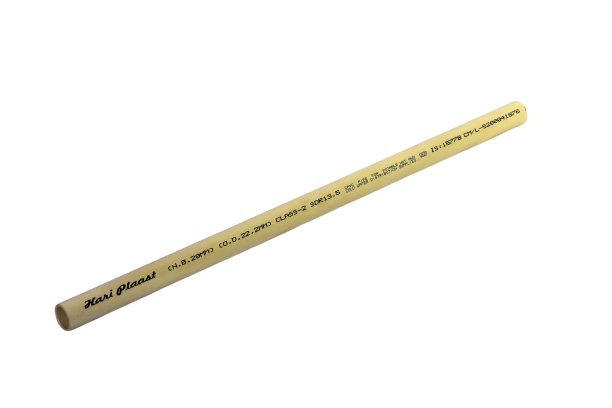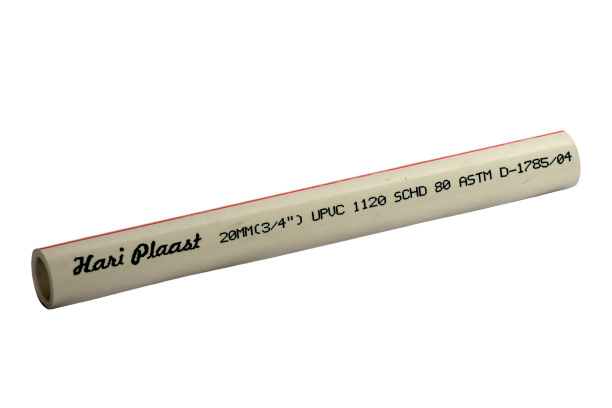“Hari plaast” PPr pipes and Fitttings for Hot and Cold water system
A successful product could be defined as one, which consistently meets the requirement of the key member of the value chain. PPr for plumbing and heating applications is a good example of this. It offers, for instance to the converters easy process ability to both pipes and fittings to system suppliers proprietary colours, to the installer excellent weldability and to the building owner no taste and odour influence, long service lifetime and excellent environmental LCA results.
What is PPr and what makes it suitable for hot water piping?
Polypropylene homopolymer, PP-H (or PP type 1) is made by polymersing propylene in the presence of a catalyst at moderate temperatures and pressures. By introducing ethylene as a co monomer during the polymerisation, polypropylene copolymer, PP-C can be produced. The monomers are built into a range of molecular weights during copolymerisation and using modern catalyst and polymerisation techniques, molecular weight distribution and molecular configuration can be carefully controlled. The ethylene can be introduced in blocks and with a higher percentage for what is classified as a “Block- Copolymer”, PP-B (or PP type 2) or at random and more dispersed for a “random copolymer”, PP-R (or PP type 3). The latter, more recent development has been further improved to obtain the best long-term heat stability, slow crack growth resistance performance and welding performance. Due to superior physical characteristics of PPr material such as working temperatures up to 95o C along with superior chemical resistance providing definite solution to oxidation and calcification, make PPr an ideal material, primarily for hot and cold water plumbing systems in buildings and industrial piping installations. Besides sanitary systems this material is used for varieties of applications like air distributions, radiator heating etc.
Product specification and range
Hari Plaast is introducing a complete replacement for Galvanised iron system by way of its Cold and Hot water system for water distribution in PPr based on DIN 8077 & DIN 8078 standards. Hari Plaast PPr pipes and fittings are available in the dimensions16 mm to 90 mm Pipes are available in 3 meters length in PN 10/SDR 11, PN 16/7.4 and PN 20/SDR 6 and fittings are available in PN 20 pressure class.
Features and Benefits
PPr raw material is hydrocarbon polymer made up basically of hydrogen & carbon which are non toxic. Density is 0.89 – 0.92g / cm3 PPr has a vicot softening point of about 131.3o C, could be used upto 95o C. For transportation of 70o C water, it can have a design lifetime 50 years which will meet the hot water supply specn. PPr has the advantage that it is quickly weldable with relatively simple socket fusion equipment. Of the different type of PP, PPr has the lowest melting point at 144o C.
Main uses
- Hot and cold water system inside building, including central heating.
- Heating system inside building including floor, wall and Radiator Heating.
- Centralised air-conditioning system and condensate pipe.
- Transport and discharge of chemicals industries.
Pipe Selection
For cold water (< 40o C) pipe, selection is made based on operating pressure. Usally minimum PN 10 and PN 16 bars pipes are chosen. For hot water pipe, selection is based on operating temperature, safety factors and operating pressure. Minimum PN 20 pipes are chosen due to reduced material strength at higher temperature. (pipe PN Class is calculated based on hoop stress 80bar at 20 C, design factor 1.25).
Jointing Procedure
Thermal and electro fusion jointing is suitable for PPr pipes and fitting connection. Threaded and flange connection is used in connection with metallic part of the system like metal pipes and taps.
Installation tools and operation notes
Tools for PPr pipe installation includes thermal fusion hand tool and cart-type tool, pressure regulator for electrofusion, tool set for heating device, cutters and supports. The heating rate of the thermal fusion tool is usually 700-800 W for pipe less than 63 mm OD and 1200-1500 W for pipe with OD above 75 mm.
DIMENSIONS OF “Hari plaast” PPr PIPES AS PER DIN 8077
| Outside diameter | Wall Thickness of pipes for pressure rating
|
|||
|---|---|---|---|---|
| Min | Max | SDR 11/PN 10
Wall Thickness |
SDR 7.4/PN 16
Wall Thickness |
SDR 6/PN 20
Wall Thickness |
| 16.0 | 16.3 | – | 2.3 | 2.7 |
| 20.0 | 20.3 | 1.9 | 2.8 | 3.4 |
| 25.0 | 25.3 | 2.8 | 3.5 | 4.2 |
| 32.0 | 32.3 | 3.0 | 4.5 | 5.4 |
| 40.0 | 40.4 | 3.7 | 5.6 | 6.7 |
| 50.0 | 50.5 | 4.6 | 6.9 | 8.4 |
| 63.0 | 63.6 | 5.8 | 8.7 | 10.5 |
| 75.0 | 75.7 | 6.9 | 10.4 | 12.5 |
| 90.0 | 90.8 | 8.2 | 12.5 | 15.0 |
WELDING TIMES OF PPr PIPES & FITTINGS
|
Pipe Dia (mm) |
Welding Depth (mm)
|
Heating Time (sec) |
Welding Time (sec) |
Cooling time (sec) |
|---|---|---|---|---|
| 20 | 14.50 | 6 | 4 | 2 |
| 25 | 16.00 | 7 | 4 | 2 |
| 32 | 18.00 | 8 | 6 | 4 |
| 40 | 20.50 | 12 | 6 | 4 |
| 50 | 23.50 | 18 | 6 | 4 |
| 63 | 27.50 | 24 | 8 | 6 |
| 75 | 30.00 | 30 | 8 | 6 |
| 90 | 37.00 | 40 | 8 | 6 |


